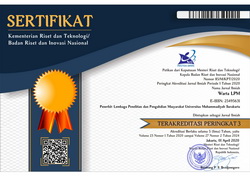Pemberdayaan Kelompok Difabel “Argodadi Pinilih” Berbasis Usaha Tani Jamur
DOI:
https://doi.org/10.23917/warta.v26i3.1862Keywords:
Disabled, farming, marketing, oyster mushroomAbstract
Disabled group "Argodadi Pinilih" has 40 active members. The COVID-19 pandemic has caused some members to lose their jobs. Members of the disabled group began to try to cultivate oyster mushrooms in their homes and they also carried out their own maintenance. Some “baglog” cannot grow mushrooms because the environment where the mushrooms grow does not meet the requirements. The problems faced by the disabled group "Argodadi Pinilih" are low quantity and quality of oyster mushrooms, limited skills in making processed food from mushrooms and mushroom marketing is still limited. The objectives of this community empowerment activity are (a) increasing the quantity and quality of mushroom production (b) improving skills in the manufacture of processed food made from mushrooms, (c) expanding the mushroom market share. The methods used in the implementation of empowerment activities are (a) counseling on oyster mushroom cultivation and marketing strategies (b) training on processing food from oyster mushrooms, (c) facilitation house of mushroom and baglog. The results of the empowerment show that the training, mentoring and facilitation of mushroom house and “baglog” can increase the quantity and quality of oyster mushroom production, improve the skills in making processed food from mushrooms and expand the market share of oyster mushrooms. The knowledge and skills of the disabled group members about mushroom farming and processing increased as evidenced by the pre-test score of 79.23 and post-test of 86.00 with an increase 8.54%.
Downloads
References
Andarwati, M., Subiyantoro, E., & Subadyo, T. (2018). Pengaruh Pelatihan dan Penerapan Teknologi Tepat Guna (TTG) Terhadap Keberdayaan Pengrajin Batik Tulis Ramah Lingkungan. BRILIANT: Jurnal Riset Dan Konseptual, 3(1), 280–286.
Badan Pusat Statistik. (2020). Kecamatan Sedayu Dalam Angka 2020. Badan Pusat Statistik.
Christita, M., & Suryawan, A. (2018). EFEKTIVITAS DAUN PEPAYA (Carica papaya) DAN CABAI RAWIT (Capsium frutescens) SEBAGAI BIOINSEKTISIDA PADA BUDIDAYA JAMUR TIRAM PUTIH (Pleurotus ostreatus) THE EFFECTIVENESS OF PAPAYA LEAVES AND CHILI PEPPER (Capsium fructescens) AS BIOINSECTICIDE FOR WHITE. Jurnal Wasian, 5(2), 79–87.
Direktorat Budidaya Tanaman Sayuran & Biofarmaka. (2010). Budidaya Jamur Tiram.pdf (p. 31).
Erpan, H., Soetoro, & Tito, H. (2017). Strategi pemasaran jamur tiram (Studi Kasus Pada Perusahaan Margi Mulyo di Desa Adimulya Kecamatan Wanareja Kabupaten Cilacap). IImiah Mahasiswa Agroinfo Galuh, 4(3), 338–343.
Hanifawati, T., & Listyaningrum, R. S. (2021). Peningkatan Kinerja UMKM Selama Pandemi Covid-19 melalui Penerapan Inovasi Produk dan Pemasaran Online. Warta LPM, 24(3), 412–426. https://doi.org/10.23917/warta.v24i3.12615
Hermanto, D. K. . S. (2011). PENINGKATAN KESEJAHTERAAN PETANI Farmers ’ Groups Empowerment as an Initial Step to Farmers ’ Welfare Improvement Khusus ( Insus ) tahun 1979 , Supra Insus tahun 1986 / 87 , peran kelompok tani ketua kelompoknya . tani pada satu wilayah administratif ( de. Analisis Kebijakan Pertanian, 9(4), 371–390.
Istiyanti, E., Fivintari, F. R., & Syaftiana, M. (2020). Potential development of oyster mushrooms in the lowlands of Bantul Regency, Special Region of Yogyakarta, Indonesia. IOP Conference Series: Earth and Environmental Science, 423(1). https://doi.org/10.1088/1755-1315/423/1/012037
Kusumawaty, Y. (2019). Strategi Pemasaran Produk Makanan Ringan Khas Riau (Keripik Nenas Dan Rengginang Ubi Kayu). Jurnal Agribisnis, 20(2), 124–138. https://doi.org/10.31849/agr.v20i2.2235
Machfudi, Supriyatna, A., & Hendrawan, H. (2021). Budidaya Jamur Tiram sebagai Peluang Usaha. Community Development Journal, 2(1), 127–135.
Mona, N., & Widyastuti, et al. (2022). Analisis Permasalahan Umur Baglog dan Hama Penyerang pada Budi Daya Jmur Tiram (Pleurotus ostreatus) di Kabupaten Semarang. Biodidaktika: Jurnal Biologi Dan Pembelajarannya, 17(2), 45–54.
Nasution, J. (2016). KANDUNGAN KARBOHIDRAT DAN PROTEIN JAMUR TIRAM PUTIH (Pleurotus ostreatus) PADA MEDIA TANAM SERBUK KAYU KEMIRI (Aleurites moluccana) DAN SERBUK KAYU CAMPURAN. Eksakta, 1(1), 38–41. http://jurnal.um-tapsel.ac.id/index.php/eksakta/article/view/48
Patimah, S. (2021). Pemberdayaan Usaha Kecil Manisan Terong Ungu Di Desa Warnasari Kecamatan Pangalengan Kabupaten Bandung. Warta LPM, 24(4), 581–592. https://journals.ums.ac.id/index.php/warta/article/view/12328%0Ahttps://journals.ums.ac.id/index.php/warta/article/download/12328/6978
Philip Kotler, G. A. (2008). Prinsip-Prinsip Pemasaran (Ed 12). Erlangga.
Rosmiah, R., Aminah, I. S., Hawalid, H., & Dasir, D. (2020). BUDIDAYA JAMUR TIRAM PUTIH (Pluoretus ostreatus) SEBAGAI UPAYA PERBAIKAN GIZI DAN MENINGKATKAN PENDAPATAN KELUARGA. Altifani: International Journal of Community Engagement, 1(1), 31–35. https://doi.org/10.32502/altifani.v1i1.3008
Sulistiyani, A. T., Aisyah, D., Mamat, I., & Sontang, M. (2016). Pemberdayaan Masyarakat Pemanfaatan Limbah Tulang Ikan untuk Produk Hidroksiapatit (Hydroxyapatite/HA) Kajian di Pabrik Pengolahan Kerupuk Lekor Kuala Terengganu-Malaysia. Jurnal Pengabdian Kepada Masyarakat (Indonesian Journal of Community Engagement), 2(1), 14. https://doi.org/10.22146/jpkm.22086
Zulfarina, Z., Suryawati, E., Yustina, Y., Putra, R. A., & Taufik, H. (2019). Budidaya Jamur Tiram dan Olahannya untuk Kemandirian Masyarakat Desa. Jurnal Pengabdian Kepada Masyarakat (Indonesian Journal of Community Engagement), 5(3), 358. https://doi.org/10.22146/jpkm.44054
Downloads
Submitted
Accepted
Published
How to Cite
Issue
Section
License
Copyright (c) 2023 Warta LPM

This work is licensed under a Creative Commons Attribution 4.0 International License.















